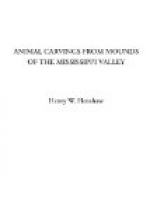So far, therefore, as the carvings themselves afford evidence to the naturalist, their general likeness entirely accords with the supposition that they were not intended to be copies of particular species. Many of the specimens are in fact just about what might be expected when a workman, with crude ideas of art expression, sat down with intent to carve out a bird, for instance, without the desire, even if possessed of the requisite degree of skill, to impress upon the stone the details necessary to make it the likeness of a particular species.
GENERALIZATION NOT DESIGNED.
While the resemblances of most of the carvings, as indicated above, must be admitted to be of a general and not of a special character, it does not follow that their general type was the result of design.
Such an explanation of their general character and resemblances is, indeed, entirely inconsistent with certain well-known facts regarding the mental operations of primitive or semi-civilized man. To the mind of primitive man abstract conceptions of things, while doubtless not entirely wanting, are at best but vaguely defined. The experience of numerous investigators attests how difficult it is, for instance, to obtain from a savage the name of a class of animals in distinction from a particular species of that class. Thus it is easy to obtain the names of the several kinds of bears known to a savage, but his mind obstinately refuses to entertain the idea of a bear genus or class. It is doubtless true that this difficulty is in no small part due simply to the confusion arising from the fact that the savage’s method of classification is different from that of his questioner. For, although primitive man actually does classify all concrete things into groups, the classification is of a very crude sort, and has for a basis a very different train of ideas from those upon which modern science is established—a fact which many investigators are prone to overlook. Still there seems to be good ground for believing that the conception of a bird, for instance, in the abstract as distinct from some particular kind or species would never be entertained by a people no further advanced in culture than their various relics prove the Mound-Builders to have been. In his carving, therefore, of a hawk, a bear, a heron, or a fish, it seems highly probable that the mound sculptor had in mind a distinct species, as we understand the term. Hence his failure to reproduce specific features in a recognizable way is to be attributed to the fact that his skill was inadequate to transfer the exact image present in his mind, and not to his intention to carve out a general representative of the avian class.




